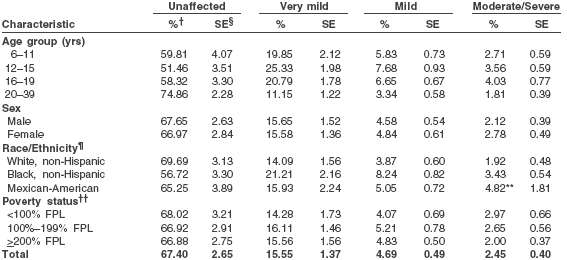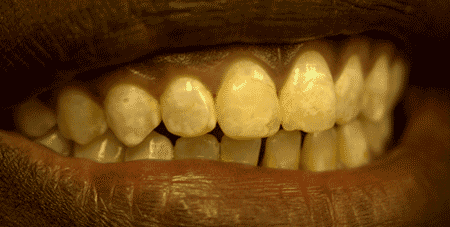In 2005, the Centers for Disease Control published the results of a national survey of dental fluorosis conducted between 1999 and 2002. According to the CDC, Black children in the United States have significantly higher rates of dental fluorosis than either white or Hispanic children. As the CDC noted, this was not the first time that Black children were found to suffer higher rates of dental fluorosis. Indeed, as documented below, at least five other studies — dating as far back as the 1960s — have found Black children in the United States are disproportionately impacted by dental fluorosis.
Not only do Black children have higher rates of fluorosis, they have more severe forms of the condition. A 2010 study from fluoridated Indianapolis found that over 12% of surveyed Black children, but none of the surveyed white children, had pitting (“a definite physical defect” of the enamel) as a result of too much fluoride exposure. (Martinez-Mier 2010). Similarly, a 1990 study from Georgia found that over 16% of Black children (versus 9% of white children) had moderate or severe fluorosis, involving either “light to very dark brown” staining, pitting; and/or “large areas” of “missing” enamel with “dark-brown stain” and “altered” tooth structure. (Williams & Zermer 1990).
It is not yet known why Blacks suffer higher rates of dental fluorosis. According to the CDC, it may be a result of ” biologic susceptibility or greater fluoride intake.” (CDC 2005). Whatever the explanation, it is clear that the Black community is being disproportionately harmed by current fluoride policies in the United States.
martinez-mier (2010) — fluorosis survey in Indianapolis, Indiana:
A fluorosis survey was conducted among 83 Black children and 102 white children in Indianapolis, Indiana (a fluoridated community). As noted by the authors, “the prevalence [of dental fluorosis] in African American children (80.1 percent) was significantly higher than in Whites (62.5 percent).” Not only was the fluorosis rate higher in the Black community, but the severity of the fluorosis was significantly greater (P < 0.001). Whereas the maximum fluorosis score in the white community registered as a two on the TSIF Scale, the maximum fluorosis score in the Black community registered as a five. A TSIF score of two refers to teeth with white staining covering “at least one-third of the visible surface, but less than two-thirds.” A TSIF score of five refers to pitting of the enamel, which is defined as “a definite physical defect in the enamel surface” which “is usually stained or differs in color from the surrounding enamel.” As the following table shows, none of the white children had a fluorosis score of five, but 12.7% of the surveyed Black children did.

FIGURE 1: Martinez-Mier EA, Soto-Rojas AE. (2010). Differences in exposure and biological markers of fluoride among White and African American children. Journal of Public Health Dentistry 70:234-40.
Centers for disease control — national survey of dental fluorosis (1999-2002):
This study by the CDC provides national fluorosis data from the 1999-2002 NHANES survey. As noted by the CDC:
“Non-Hispanic blacks had higher proportions of very mild and mild fluorosis than did non-Hispanic white participants (Figure 19). . . . No clear explanation exists why fluorosis was more severe among non-Hispanic black children than among non-Hispanic white or Mexican-American children. This observation has been reported elsewhere, and different hypotheses have been proposed, including biologic susceptibility or greater fluoride intake.”
SOURCE: Beltran-Aguilar ED et al. (2005). Surveillance for dental caries, dental sealants, tooth retention, edentulism, and enamel fluorosis — United States, 1988–1994 and 1999—2002. MMWR Surveillance Summaries 54(3): 1-44.
The following chart provides the fluorosis rates for each racial group. As can be seen, the rate of moderate/severe dental fluorosis in the Black community is almost twice as high as the rate in the white community (3.43% vs. 1.92%) and the rate of mild fluorosis is more than twice as high (8.24% vs. 3.87%). It is important to bear in mind when viewing this data that these figures are the national average, and thus include fluoridated and unfluoridated communities. Were the data limited to fluoridated communities, the fluorosis rates for all racial groups would be higher. The rates would also be higher if the chart excluded adults. For, as the chart shows, children and adolescents have higher fluorosis rates than the adults (due to the increase in fluoride exposure amongst the younger generation). Thus, the percentage of children and adolescents in fluoridated communities is almost certainly higher than the rates displayed in this table.

TABLE 23: Enamel fluorosis among persons aged 6–39 years, by selected characteristics — United States, National Health and Nutrition Examination Survey, 1999–2002.
Kumar (1999, 2000) — fluorosis Survey in Newburgh & kingston New york:
These two studies report the results of a fluorosis survey of children in a fluoridated (Newburgh) and unfluoridated (Kingston) town in New York. In both the fluoridated and unfluoridated communities, Black children were found to have higher rates of dental fluorosis. Specifically, being Black doubled the odds of getting very mild to severe dental fluorosis (odds ratio = 2.3). According to the authors:
“African-American children studied in 1995 were at higher risk for dental fluorosis than children of other racial groups. . . . The higher risk for dental fluorosis observed among African-American children is consistent with several other studies. Russell noted that dental fluorosis was twice as prevalent among African-American children than white children in the Grand Rapids fluoridation study. Because this study was conducted in an era when other sources of fluoride products were not available, this finding suggests either that fluorosis is more likely to occur in African-American children due to biologic susceptibility, or that their fluoride intake was greater.”
SOURCE: Kumar JV, Swango PA. (1999). Fluoride exposure and dental fluorosis in Newburgh and Kingston, New York: policy implications. Community Dentistry & Oral Epidemiology 27:171-80.
After finding higher rates of fluorosis in the Black community, the authors attempted to determine if the rate could be explained by low-birth weight. In their follow-up analysis in 2000, the authors again found higher rates of fluorosis among Black children. The higher rate, however, was not explained by low birth weight. According to the authors:
“The results support our earlier findings that African-American children were at higher risk for dental fluorosis in the fluoridated area. Even in the nonfluoridated area, there was a suggestion that African-American children were at higher risk. Whether this higher risk for African-American children is the result of their lower threshold for fluoride or due to other unknown sources of fluoride is not known. It has been reported that African-American children in the United States drink more water and less milk compared to white children. In Newburgh, this difference in the fluid consumption may have resulted in a higher prevalence of fluorosis in African-American children. . . . Because a race fluorosis association could have important policy implications, a large-scale study in a representative sample should be conducted to test specifically the hypothesis that African-American children are at higher risk for fluorosis.”
SOURCE: Kumar JV, Swango PA. 2000. Low birth weight and dental fluorosis: is there an association? Journal of Public Health Dentistry 60(3):167-71.
Williams & Zermer (1990) — Fluorosis Survey in Georgia:
In this study, the authors examined the rate of fluorosis in 374 children with lifelong residence in two fluoridated areas of Georgia: Augusta (0.9 to 1.2 mg/l) and Richmond County (0.2 to 0.9 mg/l). The authors found a very high fluorosis rate (81%) among the children in fluoridated Augusta, with 14% of the children having moderate or severe fluorosis. The fluorosis rate in Richmond County (54%) was also high. The authors attributed the high fluorosis rate to inappropriate fluoride supplementation by local pediatricians and dentists, as well as an increase in overall fluoride exposure from other sources. As the following table shows, Black children were found to have higher rates of moderate/severe fluorosis (TSIF score of 4 to 7) in both communities. A TSIF score of 4 refers to teeth with “light to very dark brown” staining, a TSIF score of 5 refers to teeth with a “definite physical defect” (pitting); and a TSIF score of 7 refers to teeth where “large areas of enamel may be missing and the anatomy of the tooth may be altered. Dark-brown stain is usually present.” As the table shows, 16.7% of Black children in Augusta had moderates/severe fluorosis versus 9.1% of white children. In Richmond County, the respective rates were 3.3% vs 0%.
| Dental Fluorosis Rates in Augusta & Richmond County, Georgia |
|||
| Residence/Race | No Fluorosis (TSIF Score = 0) |
Very Mild/Mild Fluorosis (TSIF Score = 1 – 3) |
Moderate/Severe Fluorosis (TSIF Score = 4 – 7) |
| City/Black | 19.6% | 63.7% | 16.7% |
| City/White | 18.2% | 72.7% | 9.1% |
| County/Black | 47.8% | 48.9% | 3.3% |
| County/White | 44.9% | 55.1% | 0% |
| SOURCE: Williams JE, Zwemer JD. (1990). Community water fluoride levels, preschool dietary patterns, and the occurrence of fluoride enamel opacities. Journal of Public Health Dentistry 50:276-81. | |||
Butler (1985) — Fluorosis Survey in 16 Texas Communities:
“The severity of dental mottling in 2,592 school-aged, lifetime residents of 16 Texas communities was investigated in 1980-81 to identify factors associated with mottling and to construct a prediction model for the prevalence of mottling. The communities were selected to obtain a wide range of levels of fluoride in the drinking water. The children within each of the communities were contacted through their schools and received a dental examination to assess the severity of mottling. Information on demographic, dental health practice, and other candidate predictor variables was obtained from a questionnaire completed by a parent. A number of water quality measurements were also recorded for each community. White and Spanish-surname children had about the same prevalence of mottling while Blacks had a higher prevalence, odds ratio (OR) = 2.3, 95% confidence interval = 1.4, 3.7.”
SOURCE: Butler WJ, et al. (1985). Prevalence of dental mottling in school-aged lifetime residents of 16 Texas communities. American Journal of Public Health 75:1408-1412.
Russell (1962): Fluorosis survey in grand rapids, michigan:
“Russell (1962), in the Grand Rapids fluoridation study, noted that fluorosis was twice as prevalent among African-American children than white children.”
SOURCE: National Research Council. (1993). Health effects of ingested fluoride. National Academy Press, Washington DC. p. 44.

